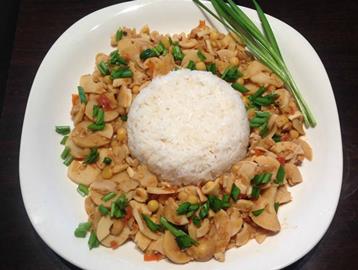Singju
A manipuri raw veg mixture

Singju (pronounced sing-zoo) is a dish from Manipur. It originated with the Meitei culture but has been widely adopted by most of the ethnic communities of the state and in some neighbouring states of Northeast India. Often served as a spicy side dish, it is also a popular as an afternoon or evening snack.
Given that its main ingredient are seasonal vegetables, Singju has many variations. However, there are two main types: Ngari-based and Thoiding-Besan based. Ngari is a kind of fermented fish, the flavor of which forms the backbone Manipuri cuisine. Roasted Ngari-based Singju is more popular in all homes, however it is not usually sold by local Singju vendors due high cost of Ngari. The Thoiding-Besan version therefore is more widely available from Singju vendors. Thoiding is an oily seed obtained from the plant Perilla frutescens which when roasted gives a nutty flavor. A mixture of roasted thoiding and roasted besan give a delicious flavor that is distinctive to Singju. This latter non-Ngari version is also served in religious feasts where fish is prohibited.
Manipur, being one of the most ancient independent kingdoms of South Asia, before becoming a part of India in 1949, has many distinctive local customs and traditions, owing to various influences throughout time. The word "Singju" comes from two words - "Manaa-Masing" and "Suba". "Manaa-Masing" means green vegetables and "Suba" means combining. Therefore, in rapid pronunciation the word "Manaa-Masing" drops to "Sing" and the word "Suba" transform to "Ju" for the better pronouncement. As a result, the word, "Singju" was born.
Singju
15 minutes
0 minutes
15 minutes
4 servings
7 ingredients
3 steps
Ingredients
Primary|
1 tsp -
Chili powder
|
||
|
1/2 cup, chopped -
Coriander leaves
|
||
|
2 cup, roughly chopped -
Cabbage
|
||
|
1 tbsp, roasted -
Besan
|
||
|
1/2 cup, chopped -
Papaya
|
||
|
3-4 pieces -
Ngari (a manipuri fermented fish)
|
||
|
1/2 cup, roasted -
Perilla seed (thoiding)
|
Directions
-
1
Making the igredients
Chop all the ingredients one by one. You can take cabbage, raw papaya, lotus root, Indian pennywort, Drop wort or any other whatever you like. -
2
Roasting the Maida, Perilla seed, Chilli, Ngari
Take the maida on a pan and roast it dry and stir regularly but don't let it burnt or smoked. Do the same with perilla seed and again chillis. You can roast or steam the ngari (if included). -
3
Making the Salad
Mix altogether, add salt as required and mash a little bit. You are ready to serve it.
Did you try this recipe? Then please do snap a picture and share it in Instagram with #lukthel.
If you liked this recipe, please do say few words in the below comment box and rate it.

You may also like
recipes feed.
- Lukthel is Manipur's #1
cooking magazine












